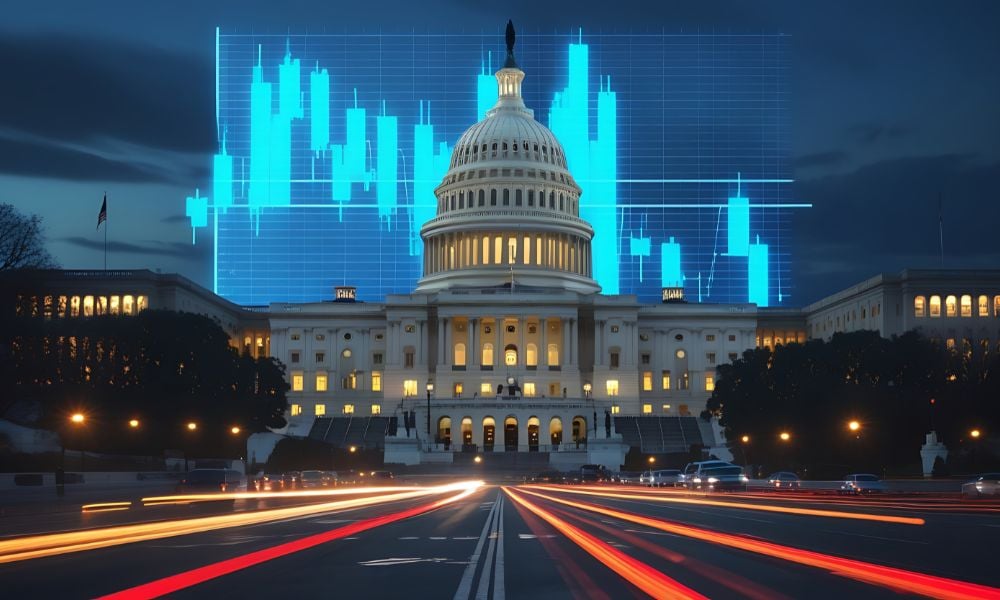CIO explains how markets have digested the uncertainty introduced by US trade policy and why pullbacks in tariffs have reintroduced risk appetites

It’s almost becoming a familiar pattern this decade. A major global event, be it a pandemic, the outbreak of a land war, or a huge shift in US trade policy, suddenly causes markets to swoon. In the aftermath of the drop, policymakers step in to reassure investors, greater clarity emerges, and markets rebound in what becomes a ‘v-shaped’ market event. David Stonehouse sees elements of that pattern in the more recent market responses to US tariff policies under President Trump.
Explaining why markets managed to rapidly shrug off the initial sentiment damage done on ‘liberation day’ Stonehouse, interim CIO at AGF Management Limited, explained that if there hadn’t been a policy response to the market correction we saw earlier this year, we could be experiencing a longer and more sustained downturn. Stonehouse explained why, despite ongoing uncertainty around US trade policy, markets have become more sanguine again and what a more risk-hungry market and a cloudy macro picture means for advisors now.
“A lot of this has been baked in. I don't think anybody thinks that at the end of all of this, tariffs are going to be zero. I think everybody recognizes that tariffs are going to be at multi-generational highs well, north of 10 per cent,” Stonehouse says. “I think maybe the market is a little too sanguine right now about when or how aggressively that's going to play out. I think maybe the market's still thinking there could be more of a kick down the road, and maybe there won't be. There's a potential for some volatility here, as it strikes home and it starts to impact businesses in the economy.”
Markets’ sanguine stance, Stonehouse explains, stems from a number of factors. One is the widely-touted TACO (Trump always chickens out) trade, which discounts tariff threats on the assumption that the President will walk them back. The decision made by the Trump administration, after markets’ initial swoon, to walk back their harshest tariffs appears to support this thesis. It’s also created something of an ‘afterglow’ that markets are still basking in.
Stonehouse notes, too, that we are seeing new forms of stimulus being introduced. That includes tax cuts in the US Big Beautiful Bill, but also includes new deficit spending measures in Germany and Canadian initiatives to speed the approval of major projects. The US Federal Reserve, also has room to cut and follow the more dovish policies pursued in other developed markets. Finally, Stonehouse notes that corporate earnings have largely been beating expectations, with momentum improving overall and buoying market sentiment as a result.
All that positivity doesn’t mean that we’re suddenly out of the woods. Stonehouse notes that US trade policy remains uncertain, which presents major issues for businesses and economic actors who can’t make definite adjustments while tariff issues remain in flux. He accepts that markets may currently be too sanguine in the face of this uncertainty. If, for example, businesses are less able to eat tariff-induced cost increases and end up passing these on to consumers there may be more volatility on the markets as consumers decide to pare back spending.
In the post ‘liberation day’ market rebound, one observed trend has been retail capital’s hunger for US assets and institutional capital’s reticence to get back in. Stonehouse explains that trend as being driven, in part, by a reallocation away form the US following 15 years of strong returns. As well, there is still enough risk out there that more sceptical investors may be looking more warily at US equity markets. Stonehouse notes, though, that at a certain point in this US market run institutional investors may be caught out and realize they need to get back in. There may be some signs of that shift already beginning. Stonehouse notes that institutions are still quite defensive position, but have shown an appetite for some US assets. Institutions are currently buying US treasury bonds at one of the highest rates in years, chasing the yield they can get from these sources.
“On the equity side of things, it's just very difficult to ignore the earnings momentum out of the US, the fact that its markets are the fastest growing, with the extremely strong positioning of the large cap tech areas,” Stonehouse says. “You ignore that at your peril.”
While capital markets continue to look good, and good enough to entice even worried money, they are contrasted by a news environment that feels uncertain and troubling. Advisors now face the unenviable task of presenting a scenario where markets are ‘climbing a wall of worry’ despite the uncertainty they supposedly hate. Small tactical tweaks, in this environment, are very hard to execute successfully. Stonehouse, for his part, argues that a focus on the long-term can be helpful.
“You want to keep your eye on the bigger, longer-term picture,” Stonehouse says. “This is really about trying to keep a steady hand on the tiller. It's about not getting too bearish, not getting too bullish. Try to put money to work when there's a bit of a pullback and maybe hold off and accumulate a bit of cash after a big run.”


